In this Issue
- Codling moth: updated spray dates table
- Blister mites on apple, pear: no action at this time of year
- Fire blight: extreme risk for infection of open flowers through May 15 in cooler counties
- Apple scab
- Coryneum blight: treat with fungicide before or after 4-hr rain event
- Tart cherry powdery mildew
- Western cherry fruit fly: treatment starts when fruits turn salmon blush color
WHAT TO WATCH FOR
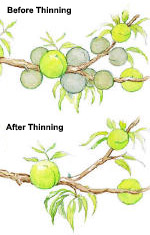 Examine leaves of apple and cherry, and fruit of peach/nectarine, for powdery mildew lesions. Apply a fungicide where necessary to prevent additional spread.
Examine leaves of apple and cherry, and fruit of peach/nectarine, for powdery mildew lesions. Apply a fungicide where necessary to prevent additional spread.- Thin apples when they are 1/2-inch in diameter, and thin peaches now, or in the next few weeks (earlier is better). On apples, thin clusters to one apple and to six inches apart. Thin peaches to 4 to 6 inches apart.
- Watch apples and pears for fire blight strikes on the flower clusters. They will show up 2 weeks after bloom.
- Continue to watch peach/nectarine and apricot for coryneum blight, and apply a fungicide before or right after 4+ hr rains.
APPLE, PEAR
Codling Moth
View a pdf of the spray timing table. Be sure to read the instructions at the top of the page, for how to read the table.
Treatment
Appleleaf and Pearleaf Blister Mites
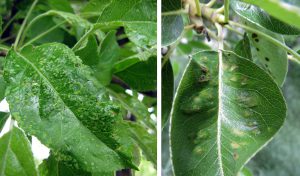
“Spots” are showing up on apple and pear leaves. These are actually blisters, and inside each one are hundreds of microscopic mites called blister mites. The minute, 4-legged mites feed inside the blisters all summer. On apple leaves, the blisters age to brown, and on pear leaves, they age to a dark brown/black.
After harvest, the mites leave the blisters and migrate to leaf buds to spend the winter.
Note that there is nothing to do for treatment at this time of year, but an application after harvest and close to leaf drop will help.
Materials to apply after harvest include Sevin (carbaryl), sulfur, or oil.
Fire Blight
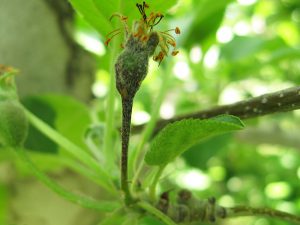
Some of the cooler areas of Utah still have blooms on apple and pear trees. The risk of infection is still EXTREME through May 15. If fire blight has been a problem, apply an antibiotic now.
Treatment for Prevention on Flowers
- Backyard: Streptomycin Fruit Tree Spray
- Commercial: click here
In other areas where bloom is complete, symptoms of fire blight infections are starting to appear. It is important to monitor your apple and pear trees every week, starting 2 to 3 weeks after bloom. Look for wilted leaves, and fruit clusters that appear shriveled and brown.
Post-infection Treatment
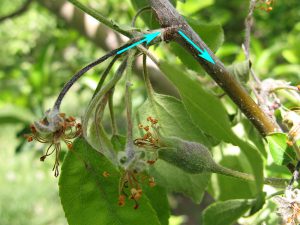
- Prune out all diseased plant parts as they are found. This will not only prevent the infections from expanding into the tree, but will also reduce the source of bacteria in the area.
- For infections that are caught early, remove twice the length of the visible symptoms.
- For infections that are caught late (that have expanded beyond the fruit cluster), it is important to make the pruning cut 10 to 12 inches beyond the visible symptoms.
- Prune in dry weather only. To be safe, wipe pruners with disinfecting wipes between cuts.
If moisture is predicted after pruning, remove the debris rather than leaving it in the orchard. If conditions are hot and dry, it is OK to leave the debris on the ground.
Apple Scab
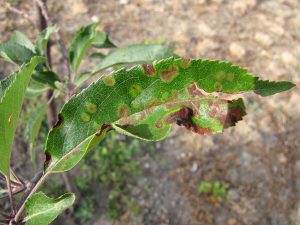
Apple scab is rare in Utah, but has been reported from some backyard trees and small orchards in Cache, Davis, and Weber counties in past years. This spring’s cool wet conditions were ideal for spread of apple scab. If this disease is present, symptoms will be showing up now.
This disease is caused by a fungus, and results in brown blotchy spots on foliage. Apple scab can also affect fruit, causing brown to black, circular scabs.
Treatment
If the disease is present, prevent further spread by applying Spectracide Immunox.
PEACH/NECTARINE, APRICOT
Coryneum Blight
The weather conditions continue to be good for spread of the fungus that causes coryneum blight (intermittent rain).
Treatment
- Backyard growers can use Spectracide Immunox, or Captan. Ideally, the fungicide should be applied before a rain storm (and provides 2 weeks of protection).
- Commercial growers can find options by clicking here. The Group 3, 7, and 11 fungicides have some curative effects, and can still be effective if applied after a rain.
CHERRY
Powdery Mildew (Tart Cherry)
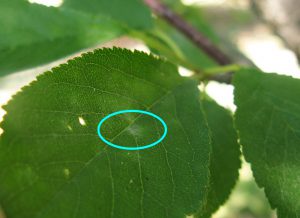
Cherry powdery mildew lesions may start to show up on tart cherries in the next few weeks. The fungus overwinters as resting spores in fallen leaves, on the orchard floor, or in bark crevices.
Infections on new leaves occurs when spring rains or summer irrigation increases the humidity under the trees, causing the resting spores to release and spread. This pathogen needs 90% humidity and temperatures between 50-78°F for infection to occur.
Leaves, fruit, and fruit pedicels can all become infected. Monitor for the earliest infections on leaves near the trunk, and on the lowest, interior twigs (where humidity is highest).
Sprays are recommended as soon as the first lesions are spotted, because prevention is the best management option for powdery mildew. Continue sprays at 7 to 14-day intervals until growth hardens off.
Commercial growers can find options by clicking here.
Western Cherry Fruit Fly
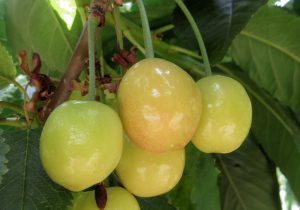
Treatment for western cherry fruit fly—the worms in the fruit—should begin as soon as cherries develop a salmon blush color. Tart cherries in most locations are still green, while sweets are coloring up. It is important to monitor your own trees for color change.
Treatment Options – Backyard Growers
Conventional:
- Malathion (malathion): every 7 days
- Ortho Flower, Fruit, and Veg. (acetamiprid): Only the concentrate container includes cherry on the label; apply every 14 days
- Sevin, Bonide Fruit Tree Spray (carbaryl): every 14 days
- Spectracide Triazicide (gamma-cyhalothrin): every 14 days
Organic:
- Green Light, Gardens Alive Bull’s Eye, Monterey (spinosad): every 7 days
- Safer BioNEEM (azadirachtin): every 7 to 10 days
Treatment – Commercial Growers
- Commercial growers, click here.
